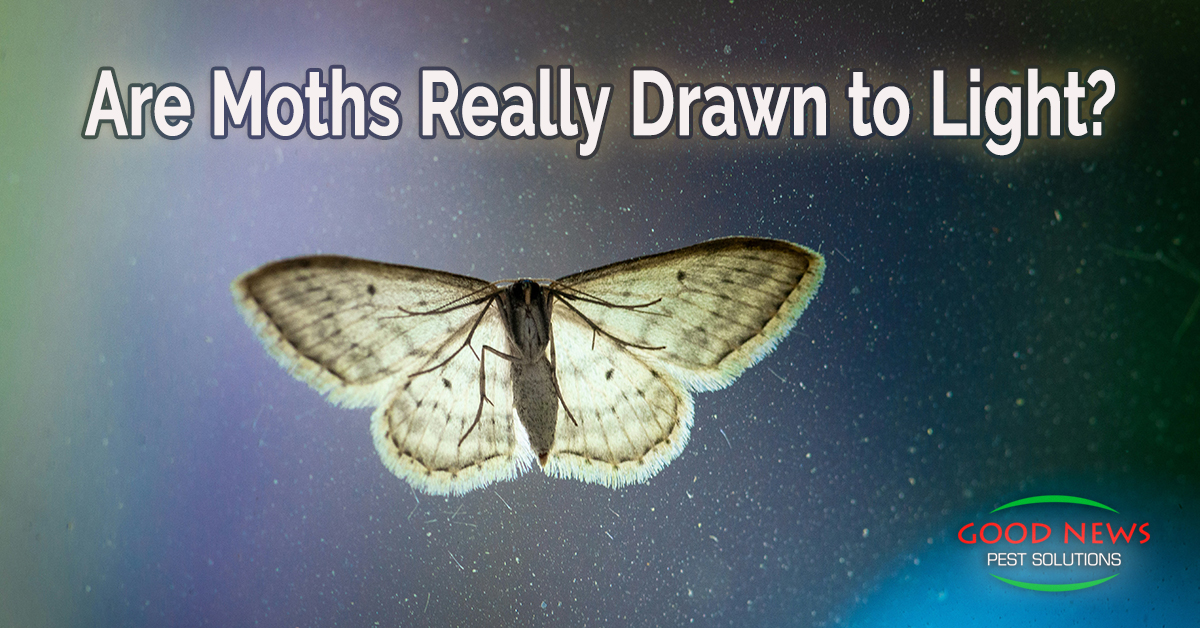
Are Moths Really Drawn to Light?
“Like a moth to a flame…” Chances are, if you haven’t uttered this exact phrase, you’ve heard someone say it – your parent, grandparent or someone on TV. But this cliché may have less truth to it than we previously thought. Or maybe it doesn’t?
When the experts are conflicted you can’t blame us for not being too sure. Let’s look at the prevailing theories on moths, what gets their attention and what it all means.
Into the Night
One thing we know for sure is that moths, unlike their butterfly cousins, are largely nocturnal.
Scientists even know that some, if not all, moths can literally slow their brains down. That’d be a good trick to learn for those restless nights! For moths, it helps them see more in dim light. Some species in particular rely on this ability to identify the plants and flowers they’re seeking and to avoid predators.
Much like ancient mariners, moths are believed to use the moon as their central point of navigation. The moon reflects the light of the sun but is still far enough away that our brains see the reflected rays of light as parallels.
If you watched the recent solar eclipse with the proper glasses, you might have noticed rays of light. As the event neared totality, the rays became brighter – forming that corona around the moon as it blocked the sun. Those rays, just like the sun shining through the cloud cover after a storm, appear to be individual and distinct. They’re really just the part we can see of the sun burning in outer space – because the light hits our eyes in parallel.
For moths, that means they can see a long, clear path in a direction. The moon rays become like a GPS chart in the sky for the moths to follow.
Dance by the Light of the Moon
Another way the lunar disc influences moths is in their mating patterns. Entomologists have studied and found that not only do moon rays provide a nice map to get where you’re going, they can also serve as Moth Match.com. Male moths in particular use the moon as a navigation point to get to the females faster.
Yet another theory from decades ago is that the movement and flicker of candle flame mimics the same electromagnetic energy emitted by insect pheromones. In other words, seeing the flame motion triggers instinctual arousal in the moth’s brain, just like smelling a female moth who’s ready to mate.
Paradise by the Dashboard Light
A more recent theory of moths’ attention to flames and artificial lights was proposed by a study coordinated by Florida International University in Miami.
Researchers used motion-capture cameras and filmed with infrared lights – a spectrum moths cannot see - to see exactly how they behaved when they were centered around a light source. They discovered that the moths actually turned their backs to the light while they were flying.
They weren’t attracted to the light, but confused and distracted.
“Maybe when people notice it, like around their porchlights or a streetlamp, it looks like they are flying straight at it, but that’s not the case,” said co-lead study author Yash Sondhi, a postdoctoral researcher at the Florida Museum of Natural History.
It seems moths, like many nocturnal creatures, keep their backs to the brightest source of light. When that’s the moon, it keeps them level and flying relatively straight. When it’s not, or when there are multiple sources of light, it can become a serious problem.
Artificial ALAN
Regardless of why moths are drawn to lights, the bottom line is that they are. Artificial lights – like on our porches, are usually brighter and more distinct than the moon, drawing the moth’s attention. And as we build and build, it gets harder for the moths to distinguish any moon light at all.
It’s not just a moth problem either. Researchers say artificial light at night (ALAN), or “light pollution” is a significant factor in several insects’ diminishing populations.
In the FIU study, hundreds of slow-motion videos captured the behaviors of butterflies, moths, bees, wasps, dragonflies and more. Almost without fail, the majority of the insects studied maneuvered to keep their backs to the light – even when it caused them to stall, spin or drop out of flight.
Just six years ago, a scientific team comprised of German, British and American researchers published a study that identified a 2.2% increase in the Earth’s outdoor artificial lighting each year between 2012 and 2016. Some of the same scientists later found that artificial light was making the night sky twice as bright every eight years.
Light pollution is damaging to insects and wildlife, causing habitat loss and fragmentation. If that’s not bad enough, it also creates issues for us. Increased nighttime light reduces our bodies’ ability to produce melatonin. So, we sleep less and suffer from more fatigue, headaches, stress, anxiety, and other health problems - including cancer.
A Little Night Music
So what can we do? Scientists say we should start by shutting off the lights we don’t need on. Porch lights are often a protection against burglars and other troublesome pests, but they are just as effective when triggered by motion detectors. That saves you electricity, lowers light pollution, and keeps you safe.
Changing out bright bulbs for yellow or red helps too. While they are not as much of an issue in some ways, the latest LED bulbs are usually bright white. Yellow and red are less of a draw or confusion for nocturnal insects. LEDs can be set this way too if you get the right ones.
In addition to swapping out bulbs and setting up motion detectors or timers, take the time to make sure any outdoor lights are aimed down and properly shielded. Keeping them at the right angle not only broadens the coverage of your lights should intruders or animals approach, but keeping them from leaking up into the night sky can truly make a difference.
For all the insects that might make it into your home, that’s where we come in. Our most popular solution – Go Green Perimeter Plus – gets rid of bugs in your house and keeps new ones from intruding. Another “plus” is that it’s affordable and safe for your family and pets with none of the harsh insecticides other pest control services may offer. For more details, or to set up your first appointment, just give us a call!
« Back to Blog
Proudly Serving
Sun City Center, Ruskin, Palmetto, Parrish, Ellenton, Bradenton, Anna Maria, Holmes Beach, Bradenton Beach, Longboat Key, Lakewood Ranch, University Park, Myakka City, Sarasota, Siesta Key, Osprey, Nokomis, Casey Key, Venice, Englewood, North Port, Port Charlotte, Punta Gorda, Arcadia
Things You Can Do
Pay Your Bill Online
Leave Us a Review
Request a Free* Termite Inspection
Stop Mosquito Bites
Get Rid of Rodents
Get a Termite Damage Warranty
Get Pest Control for Your Attic
Get Pest Control for Your Business Request Prayer
Corporate Address
1080 Enterprise Court, Ste A
North Venice, FL 34275
Call Now: (941) 412-9610
Text: (941) 412-9610
Fax: (941) 412-0080
